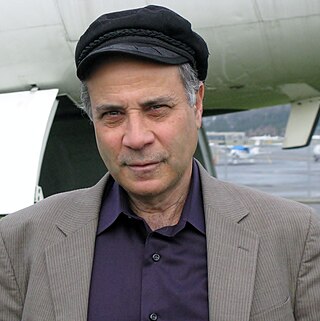
Robert Zubrin is an American aerospace engineer, author, and advocate for human exploration of Mars. He and his colleague at Martin Marietta, David Baker, were the driving force behind Mars Direct, a proposal in a 1990 research paper intended to produce significant reductions in the cost and complexity of such a mission. The key idea was to use the Martian atmosphere to produce oxygen, water, and rocket propellant for the surface stay and return journey. A modified version of the plan was subsequently adopted by NASA as their "design reference mission". He questions the delay and cost-to-benefit ratio of first establishing a base or outpost on an asteroid or another Apollo program-like return to the Moon, as neither would be able to provide all of its own oxygen, water, or energy; these resources are producible on Mars, and he expects people would be there thereafter.
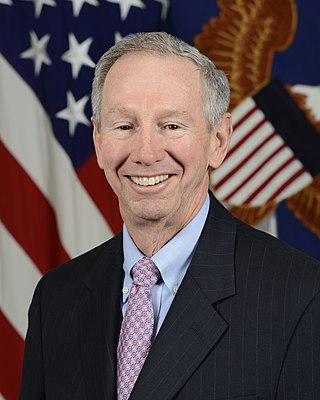
Michael Douglas Griffin is an American physicist and aerospace engineer who served as the Under Secretary of Defense for Research and Engineering from 2018 to 2020. He previously served as Deputy of Technology for the Strategic Defense Initiative, and as Administrator of NASA from April 13, 2005, to January 20, 2009. As NASA Administrator Griffin oversaw such areas as private spaceflight, future human spaceflight to Mars, and the fate of the Hubble telescope.

Aerocapture is an orbital transfer maneuver in which a spacecraft uses aerodynamic drag force from a single pass through a planetary atmosphere to decelerate and achieve orbit insertion.

Ernst Stuhlinger was a German-American atomic, electrical, and rocket scientist. After being brought to the United States as part of Operation Paperclip, he developed guidance systems with Wernher von Braun's team for the US Army, and later was a scientist with NASA. He was also instrumental in the development of the ion engine for long-endurance space flight, and a wide variety of scientific experiments.

Juan R. Cruz, Ph.D., is a Puerto Rican aerospace engineer who played an instrumental role in the design and development of the Mars Exploration Rover (MER) and Mars Science Laboratory (MSL) parachute.
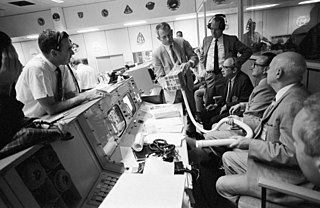
Aerospace engineering is the primary field of engineering concerned with the development of aircraft and spacecraft. It has two major and overlapping branches: aeronautical engineering and astronautical engineering. Avionics engineering is similar, but deals with the electronics side of aerospace engineering.
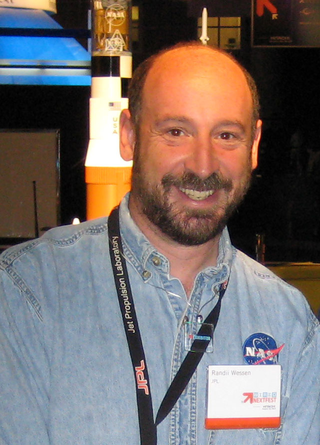
Randii Ray Wessen is an American astronautics systems engineer specifically involved in planetary exploration, experimental economist, and writer. Dr. Wessen has been an employee of the California Institute of Technology's Jet Propulsion Laboratory since 1984. He is currently the A-Team Lead Study Architect for JPL's Innovation Foundry. On the side, Wessen works with Dr. David Porter of Chapman University in the field of Experimental Economics, where they are designing a system to help allocate resources for building instruments on robotic deep space planetary spacecraft. This proposed system will build on the success of the Cassini Resource Exchange and be applied to NASA's Outer Planet Flagship Missions.
Eugene F. Lally was American aerospace engineer. He worked in the early 1960s on U.S. interplanetary space programs. Beside his space programs he was also an inventor and developed non-space products with his own company Dynamic Development Co. which he founded in the early 1960s. He later became an active amateur photographer and lubrication product entrepreneur. Lally contributed articles for popular space, astrobiology, photography, travel, and archaeology magazines. He was also a speaker at local space exploration and extraterrestrial intelligence (UFO) society meetings where he gave first-hand accounts of the early U.S. space program, commentaries on current U.S. space exploration activities and the search for extraterrestrial intelligence.
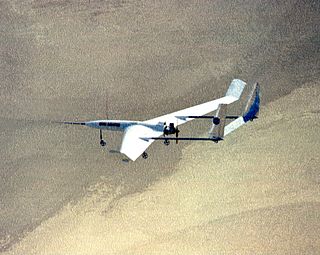
A Mars aircraft is a vehicle capable of sustaining powered flight in the atmosphere of Mars. So far, the Mars helicopter Ingenuity is the only object to ever fly on Mars, completing 39 successful flights covering 7.90 km (4.91 mi) in 1 hour, 4 minutes and 20 seconds of flight time.

Adam Diedrich Steltzner is an American NASA engineer who works for the Jet Propulsion Laboratory (JPL). He worked on several flight projects including Galileo, Cassini, Mars Pathfinder, Mars Exploration Rovers (MER). He was the lead engineer of the Mars Science Laboratory's EDL phase, and helped design, build and test the sky crane landing system.
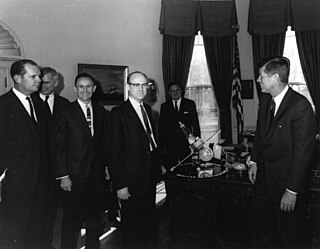
Robert J. "Bob" Parks was a US aerospace engineer and pioneer in the space program where he was intricately involved and/or directed for some of the most historic and important U.S. unmanned space missions. Over a 40-year tenure at the Jet Propulsion Laboratory (JPL/NASA), located in Pasadena, California, Parks’ impact was essential to helping the United States lead the world in space exploration. He served as Guidance Engineer for Explorer 1, the first successfully launched satellite by the United States. He directed the initial flyby missions to the Moon, the first soft landing on the moon, the world's first successful mission to another planet and initial missions to Mars, Saturn, Jupiter and Uranus. Parks concluded his career as Deputy Director of the JPL/NASA and retired in 1987. Some of the awards he received for his work include the NASA Exceptional Service Medal (1967), the Stuart Ballantine Medal (1967), the Goddard Astronautics Award (1980) and the Caltech Distinguished Alumni Award in 1982.
Robert Samuel Kraemer was an American aerospace engineer who served as Director of Planetary Programs at the National Aeronautics and Space Administration from 1971 to 1976.
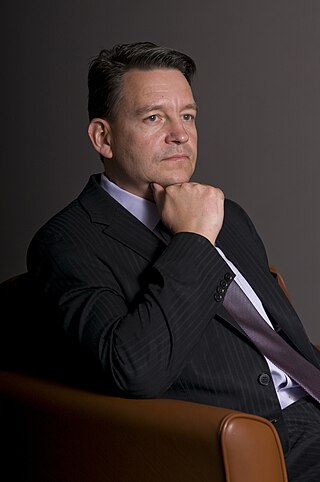
Olivier L. de Weck is the Apollo Program Professor of Astronautics and Engineering Systems at the Massachusetts Institute of Technology (MIT). He has authored and co-authored more than 400 peer-reviewed publications. He is a Fellow of the INCOSE and a Fellow of the AIAA. He is the Editor-in-Chief of the Journal of Spacecraft and Rockets. From 2013-2018 de Weck served as the Editor-in-Chief for Systems Engineering, the leading journal of INCOSE. He is best known for contributions to the fields of Systems Engineering, Design optimization, and Space Logistics, where together with colleagues from JPL he coined the term Interplanetary Supply Chain. More recently he has become active in the field of Remote Sensing.

David A. Spencer is the Mars Sample Return Campaign Mission Manager at the Jet Propulsion Laboratory. As an aerospace engineer, Spencer designs and operates planetary spacecraft.
George Henry Born was an American aerospace engineer, Distinguished Professor, founder and Director Emeritus of the Colorado Center for Astrodynamics Research (CCAR) at the University of Colorado Boulder. He is known for his work in satellite navigation and precise orbit determination. He worked on various missions while at the Jet Propulsion Laboratory as well as navigation support for the Apollo program in the late 1960s while at Johnson Space Center.

James Michael Longuski is an American scientist, inventor, writer, and educator known for his contributions to astrodynamics and space mission design. After working as a space mission designer at Jet Propulsion Laboratory (JPL) for NASA, Longuski has served as a professor at Purdue University School of Aeronautics and Astronautics since 1988.

Moriba Kemessia Jah is an American space scientist and aerospace engineer who describes himself as a "space environmentalist", specializing in orbit determination and prediction, especially as related to space situational awareness and space traffic monitoring. He is currently an associate professor of Aerospace Engineering and Engineering Mechanics at the University of Texas at Austin. Jah previously worked as a spacecraft navigator at the NASA Jet Propulsion Laboratory, where he was a navigator for the Mars Global Surveyor, Mars Odyssey, Mars Express, Mars Exploration Rover, and his last mission was the Mars Reconnaissance Orbiter. He is a Fellow of the American Astronautical Society, the Air Force Research Laboratory, the International Association for the Advancement of Space Safety and, the Royal Astronomical Society. Jah was also selected into the 10th anniversary class of TED Fellows and was named a MacArthur Fellow in 2022. He also was selected into the AIAA class of Fellows and Honorary Fellows in the year of the 50th Anniversary of Apollo 11. The AIAA "confers the distinction of Fellow upon individuals in recognition of their notable and valuable contributions to the arts, sciences or technology of aeronautics and astronautics."
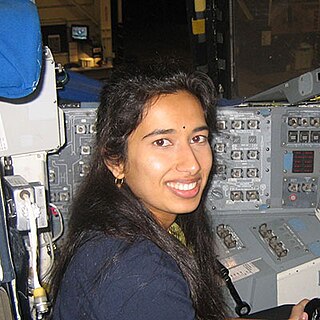
Swati Mohan is an American aerospace engineer and was the Guidance and Controls Operations Lead on the NASA Mars 2020 mission.

David Y. Oh is an American spacecraft systems engineer and expert in electric propulsion. Oh currently works at the Jet Propulsion Laboratory (JPL) as the NASA Psyche mission Project Systems Engineering Manager. Prior to his role on Psyche, he was the cross-cutting phase lead and lead flight director for the NASA Mars Science Laboratory mission and was recognized in popular media for living on Mars time with his family during the month following the landing of the Curiosity rover.
















